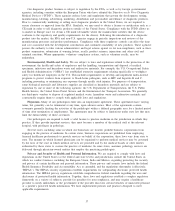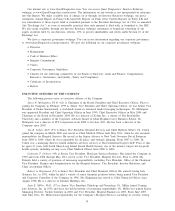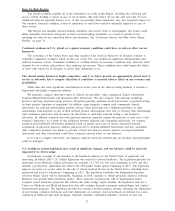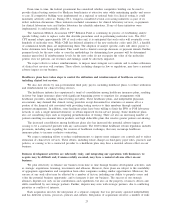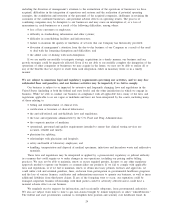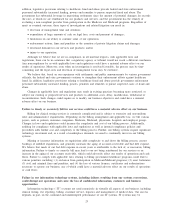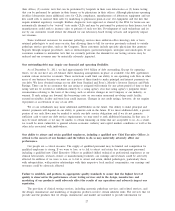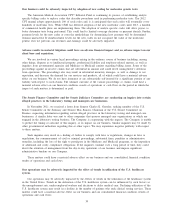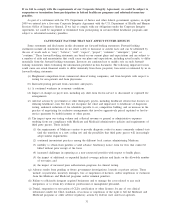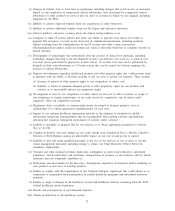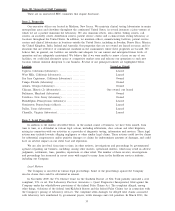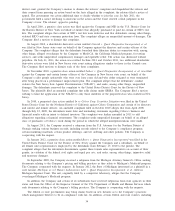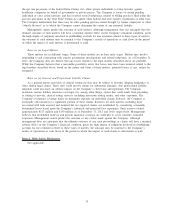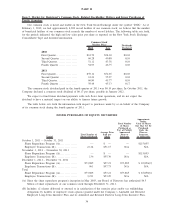Quest Diagnostics 2011 Annual Report Download - page 32
Download and view the complete annual report
Please find page 32 of the 2011 Quest Diagnostics annual report below. You can navigate through the pages in the report by either clicking on the pages listed below, or by using the keyword search tool below to find specific information within the annual report.vulnerable to damage, disruptions and shutdown from a variety of sources, including telecommunications or
network failures, human acts and natural disasters. Moreover, despite the security measures we have implemented,
our IT systems may be subject to physical or electronic intrusions, computer viruses, unauthorized tampering and
similar disruptive problems. We have taken precautionary measures to prevent unanticipated problems that could
affect our IT systems. Nevertheless, we may experience damages to our systems, system failures and interruptions
and unauthorized disclosure of confidential information, and our data could be compromised.
In addition, we are in the process of implementing standard laboratory information and billing systems,
which we expect will take several years to complete. Failure to properly implement this standardization process
could materially adversely affect our business. During system conversions of this type, workflow is re-engineered
to take advantage of best practices and enhanced system capabilities, which may cause temporary disruptions in
service. In addition, the implementation process, including the transfer of databases and master files to new data
centers, presents significant conversion risks that need to be managed carefully.
If we experience systems problems, including with our implementation of standard laboratory or billing
systems, they may interrupt our ability to operate. For example, the problems may impact our ability to process
test orders, deliver test results or perform or bill for tests in a timely manner.
If we experience systems problems, or if we experience unauthorized disclosure of confidential information,
it could adversely affect our reputation, result in a loss of customers and revenues and cause us to suffer
financial damage, including significant costs to alleviate or eliminate the problem.
Failure to develop, or acquire licenses for, new tests, technology and services, could negatively impact our
testing volume and revenues.
The diagnostics testing industry is faced with changing technology and new product introductions. Other
companies or individuals, including our competitors, may obtain patents or other property rights that would
prevent, limit or interfere with our ability to develop, perform or sell our tests or operate our business or increase
our costs. In addition, they could introduce new tests that may result in a decrease in the demand for our tests or
cause us to reduce the prices of our tests. Our success in continuing to introduce new tests, technology and
services will depend, in part, on our ability to license new and improved technologies on favorable terms. We
may be unable to develop or introduce new tests. We also may be unable to continue to negotiate acceptable
licensing arrangements, and arrangements that we do conclude may not yield commercially successful diagnostic
tests. If we are unable to license these testing methods at competitive rates, our research and development costs
may increase as a result. In addition, if we are unable to develop and introduce, or license, new tests, technology
and services to expand our esoteric testing business, our testing methods may become outdated when compared
with our competition and our testing volume and revenue may be materially and adversely affected.
We may be unable to obtain, maintain or enforce our intellectual property rights and may be subject to
intellectual property litigation that could adversely impact our business.
We may be unable to obtain or maintain adequate patent or other proprietary rights for our products and
services or to successfully enforce our proprietary rights. In addition, we may be subject to intellectual property
litigation and we may be found to infringe on the proprietary rights of others, which could force us to do one or
more of the following:
•cease developing, performing or selling products or services that incorporate the challenged intellectual
property;
•obtain and pay for licenses from the holder of the infringed intellectual property right;
•redesign or reengineer our tests;
•change our business processes; or
•pay substantial damages, court costs and attorneys’ fees, including potentially increased damages for any
infringement held to be willful.
The development of new, more cost-effective tests that can be performed by our customers or by patients,
or the internalization of testing by hospitals or physicians, could negatively impact our testing volume and
revenues.
Advances in technology may lead to the development of more cost-effective tests that can be performed
outside of a commercial clinical laboratory such as (1) point-of-care tests that can be performed by physicians in
26



